Events and excursions, Autumn 2010
Visit to Upton Hall
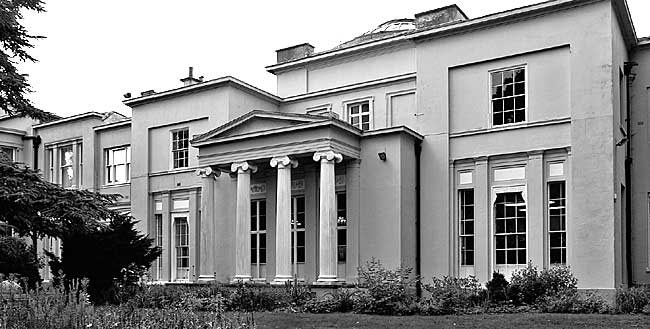
Thursday, 10 September 2010 saw a large group of members met at Upton Hall, the home of the British Horological Institute, for a tour of the Hall and the BHI museum.
We were taken into the Ballroom and received an introductory talk on the history of both the Institute and the Hall by Briony Dickenson, a member of staff who has been researching the Hall's history together with that of its various occupants and owners. After the talk Briony took us into the museum and introduced us to some of the time pieces, including a very large one made by a local joiner, where every part 'Marilyn Munroe' clock because of the hourglass shape of its frame. This clock was made out of wood apart from the weights. Another was an American clock known as the Marilyn Monroe clock because of its hourglass shape. This clock was made by Benjamin Franklin with a simple mechanism and a one handed face.
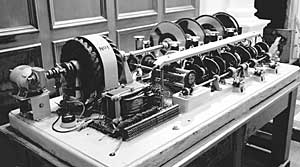
Our third introduction was to the original speaking clock used for the telephone service's time information service. We were told how the voice was selected and the work the Swiss designer had to undertake on the recording to remove a slight hiss on certain sounds caused by the tooth configuration of the lady selected to make the recordings. There was plenty of time to view the full collection and Briony, together with the Institute's General Manger, on hand to answer any questions.
The British Horological Institute was founded 15 June 1858 by London watchmakers who were concerned to protect themselves from cheap American imports. It was an immediate success and within its first year had established night school courses, a college, a library and a museum. It occupied premises in Northampton Square, London until its later move to Upton Hall. During World War 2 the roof of the London premises was blown off twice, by a bomb and then a doodlebug (the penultimate one to fall on London). The roof was repaired by quick patching on both occasions and, by the 1950s, required a lot of expensive work. The decision was therefore made to relocate to a more central position in England where servicing its 3,000 world-wide membership could be more efficiently carried out.
A suitable venue was found at Upton Hall, Nottinghamshire, which was bought for £30,000 and occupied by the Institute in 1972. The London premises were sold for £205,000 but the difference has been taken up over the years in renovating and preserving Upton Hall.
The Hall is a grade 2* listed building on a site said to date back to AD956 when King Edwyn gave the land to Archbishop Oscytel of York. In 1335 Robert Bagenham had his home here and in the Civil War period the Squire was Martin Oglethorpe, part of whose Elizabethan house can still be seen. The Upton Enclosure map of 1790 shows a building on the site and this was owned by Robert Smith, MP, the third son of Abel Smith, the Nottingham banker.
However, Robert lived at Normanton Hall near Southwell and not at Upton. Robert had a successful political career and in 1796 became Baron Carrington of Upton. Why the name 'Carrington' was chosen is not known even in the Carrington family whose name will be familiar to members through the 6th Lord Carrington, a Minister in Margaret Thatcher's governments.
Early in the 19th century, the house was in the possession of Thomas Wright, third son of Thomas Wright another Nottingham banker. Thomas, the son, was destined to become a clergyman at his father's wish who left money to buy his son a parish and living to support him. However, it appears that Thomas had other ideas and married a wealthy widow, Sophia Frances who had been the wife of John Sutton, eldest son of Sir Robert Sutton Bt. Of Norwood Hall. Thomas and Sophia lived at Norwood but never owned that house.
The main part of the current house at Upton was built in neo-classical style by Thomas between 1828 and 1832 using the architect, W. H. Dunthorne (one of the founders of the Royal Institute of British Architects) and the house was then used to hold Thomas' extensive collection of paintings which, when sold by Christies after he died in January 1845, contained important works by painters such as Reynolds and van Dyke amongst others.
In 1855 the house was sold to Philip Richard Faulkner, a solicitor from Newark, who lived in it until 1894 without making any real changes. It was bought in 1894 by John Francis Warwick of the Warwick and Richardson brewery firm of Newark, and it was he who extended the house to build the west wing which houses the ballroom. In extending the house the symmetry of the original was lost. In 1895 a central heating system was installed.
In 1936 the house was bought by property developer, Sir Albert Ball, who sold it in 1941 to the Fathers of the Holy Ghost. However, it was requisitioned in 1942 to house partly sighted children evacuees and so did not become a seminary until 1945 with the title of St. Joseph's Roman Catholic Theological Church.
The Hall was bought by the BHI in 1972 and they moved there in 1973 and have very carefully undertaken repairs and renovations to return the house to its original character. The Institute is to be congratulated for the way in which they are caring for the house.
LANDSCAPE HISTORY OF SHERWOOD FOREST AND NOTTINGHAMSHIRE A CONFERENCE REPORT by John Beckett
On 11 September 2010 over 90 people, including members of the Thoroton Society, gathered at Nottingham Contemporary for a day conference arranged by the Society for Landscape Studies in partnership with the Thoroton Society.
The conference looked at different aspects of the Nottinghamshire landscape and papers were given on Nottinghamshire in the Bronze Age and the Iron Age, and through the Viking ear, as well as on Major Hayman Rooke's attempts to reconstruct the county in the Roman period.
We learnt about coal mining in the medieval period, and were shown a newly reconstructed map of Sherwood Forest for the same time. Not surprisingly, much of the day was concentrated on the Dukeries, with papers on Welbeck, Rufford (in the eighteenth century and the twentieth century), and Clumber. We hope that some of the papers will eventually appear in Transactions, and also that several of the lecturers might be induced to speak to the Society on future occasions.
THE SOCIETY'S ANNUAL LUNCHEON 2010
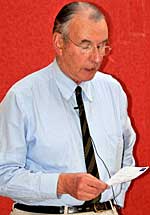
Sir Andrew Buchanan, The Lord Lieutenant for Nottinghamshire, proposing the toast to The Thoroton Society.
By Barbara Cast, Honorary Secretary Once again we struck lucky with our choice of venue for this year's annual luncheon. The Charnwood Hotel at Blyth is a pleasant hotel, well run and the staff were warm and welcoming. The meal itself was excellent, not even a tiny whisper of complaint was heard! The waiting staff were extremely professional, serving the food on hot plates at table in the old fashioned way which everyone appreciated.
We were honoured and pleased to welcome Sir Andrew and Lady Belinda Buchanan as our guests. Sir Andrew is, as I am sure you know, the Lord Lieutenant for Nottinghamshire, acting as the Queens representative in the County. He is, therefore, a very busy man and, after lunch, he told us a little of the role and of the activities in which he is involved. He is due to retire on 21st July 2012, the day after the main festivities for the Queen's Diamond Jubilee have finished, so it will be a splendid last year in office for him.
Lady Belinda and he are pleased to have recently moved to a smaller house near to Hodsock Priory, leaving their son George and his wife to manage the big house and its wonderful snowdrop garden. Sir Andrew's farming is still an important part of his life and he looks forward to spending more time on it.
Members enjoyed the event which was blessed with excellent weather. If you haven't been to a Society Lunch yet, book it in your diary for next year - they are always enjoyable. Where will it be in 2011?
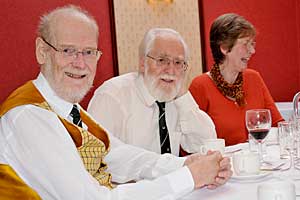 |
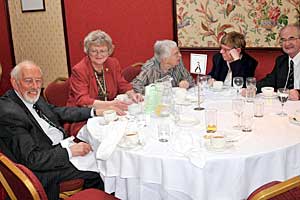 |